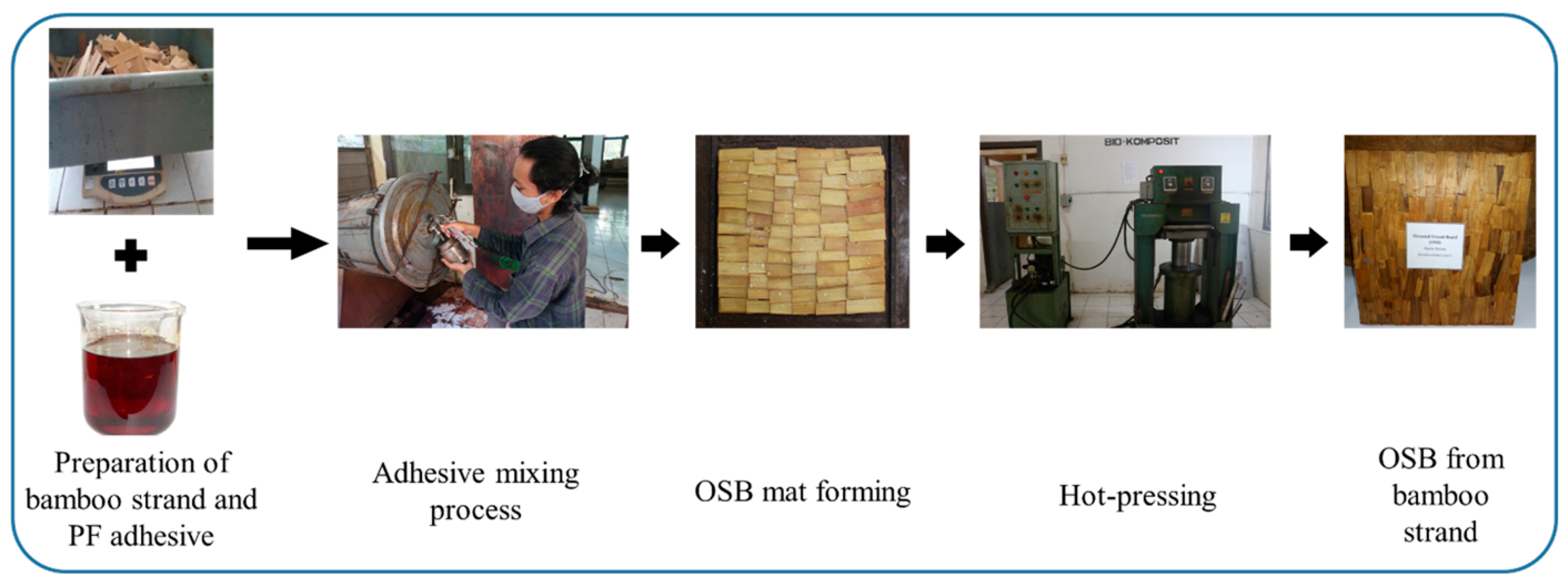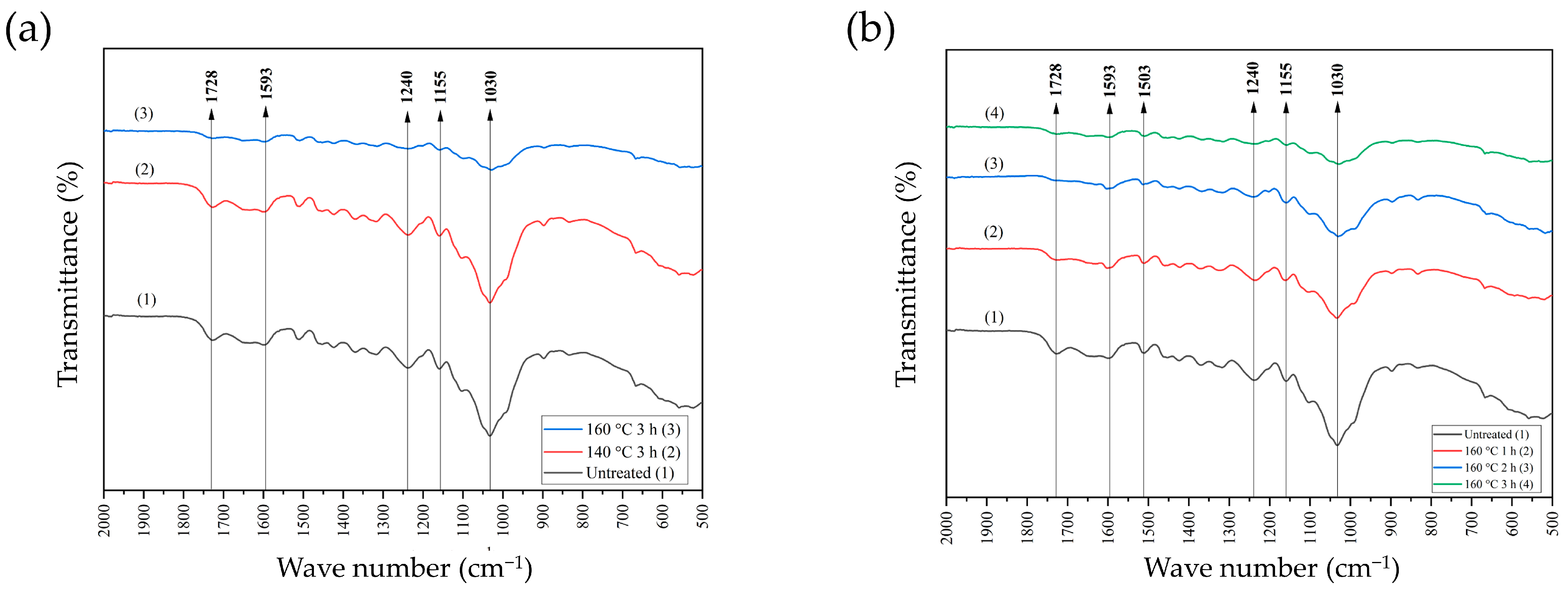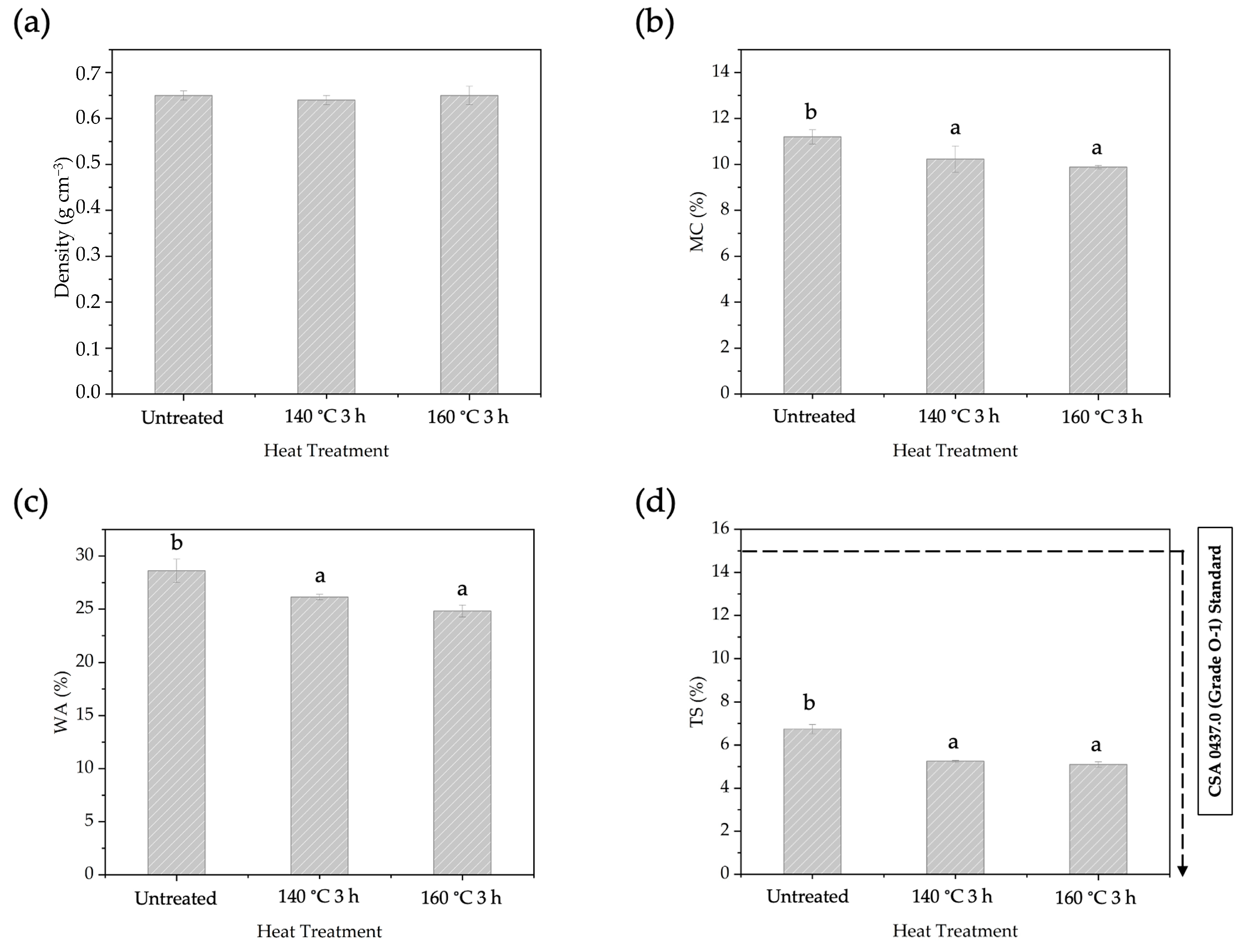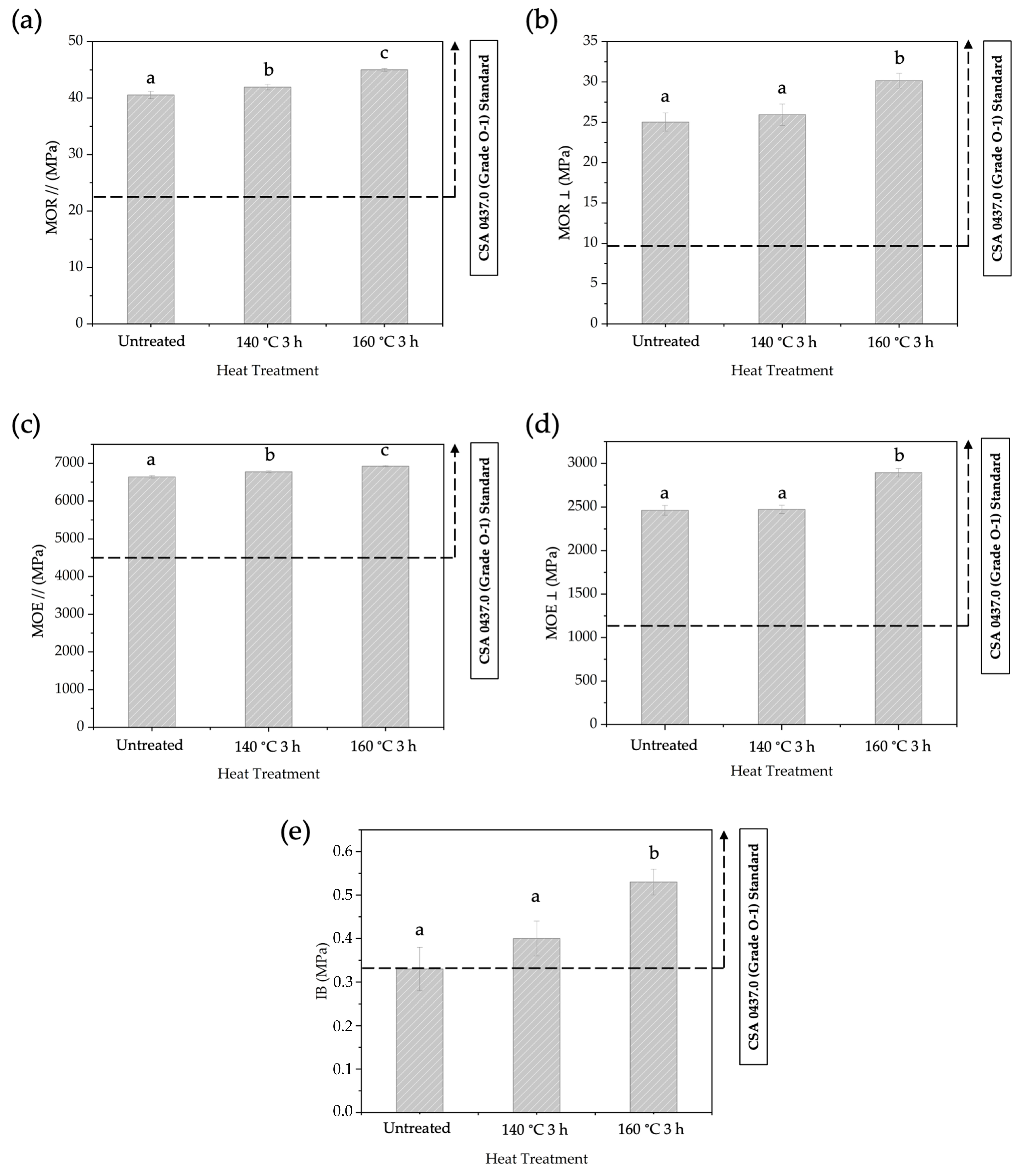Performance of Oriented Strand Board Made of Heat-Treated Bamboo (Dendrocalamus asper (Schult.) Backer) Strands
Abstract
1. Introduction
2. Materials and Methods
2.1. Materials
2.2. Characterization of Adhesives
2.3. Preparation of Heat-Treated Bamboo Strands
2.4. Characterization of Bamboo Strands
2.5. Functional Groups and Crystallinity Analysis of Bamboo Strands
2.6. Fabrication of Bamboo Oriented Strand Boards (BOSBs)
2.7. Physical and Mechanical Properties of BOSB
2.8. Statistical Analysis
3. Results and Discussion
3.1. Adhesives Properties
3.2. Chemical Composition
3.3. Functional Group Analysis of Heat-Treated Bamboo Strands
3.4. Crystallinity of Heat-Treated Bamboo Strands
3.5. Properties of BOSB Panels
3.5.1. Effects of Heat Treatment Temperature on BOSB Properties
3.5.2. Effects of Heat Treatment Duration on BOSB Properties
4. Conclusions
Author Contributions
Funding
Institutional Review Board Statement
Data Availability Statement
Acknowledgments
Conflicts of Interest
References
- Osman, S.; Ahmad, M.; Zakaria, M.N.; Zakaria, A.M.; Ibrahim, Z.; Abu, F.; Bahari, S.A.; Wan Jaafar, W.N.R. Bamboo as Future Bio-Industrial Material: Physical Behaviour and Bending Strength of Malaysia’s Beting Bamboo (Gigantochloa Levis). IOP Conf. Ser. Earth Environ. Sci. 2022, 951, 012001. [Google Scholar] [CrossRef]
- Manandhar, R.; Kim, J.-H.; Kim, J.-T. Environmental, Social and Economic Sustainability of Bamboo and Bamboo-Based Construction Materials in Buildings. J. Asian Archit. Build. Eng. 2019, 18, 49–59. [Google Scholar] [CrossRef]
- Sun, Y.; Jiang, Z.; Liu, H.; Sun, Z.; Fang, C. The Bending Properties of Bamboo Strand Board I-Beams. J. Wood Sci. 2019, 65, 50. [Google Scholar] [CrossRef]
- Maulana, M.I.; Fitrianum, F.; Noviyanti, D.; Audy, R.; Prasetia, D.; Maulana, S.; Lubis, M.A.R.; Hidayat, W.; Sari, R.K.; Febrianto, F.; et al. Effect of Pretreatment and Compaction Ratio on the Properties of Oriented Strand Board from Sengon (Paraserianthes Falcataria L. Nielsen) Wood. Wood Mater. Sci. Eng. 2023, 19, 206–219. [Google Scholar] [CrossRef]
- Maulana, S.; Gumelar, Y.; Fatrawana, A.; Maulana, M.I.; Hidayat, W.; Sumardi, I.; Wistara, N.J.; Lee, S.H.; Kim, N.H.; Febrianto, F. Destructive and Non-Destructive Tests of Bamboo Oriented Strand Board under Various Shelling Ratios and Resin Contents. J. Korean Wood Sci. Technol. 2019, 47, 519–532. [Google Scholar] [CrossRef]
- Liu, X.; Guan, X.; Guo, M. Chemical Componts of Moso Bamboo (Phyllostachys Heterocycla Var. Pubscense) Culm at Different Ages and Heights. Appl. Ecol. Environ. Res. 2019, 17, 4193–4203. [Google Scholar] [CrossRef]
- Maulana, M.I.; Murda, R.A.; Purusatama, B.D.; Sari, R.K.; Nawawi, D.S.; Nikmatin, S.; Hidayat, W.; Lee, S.H.; Febrianto, F.; Kim, N.H. Effect of Alkali-Washing at Different Concentration on the Chemical Compositions of the Steam Treated Bamboo Strands. J. Korean Wood Sci. Technol. 2021, 49, 14–22. [Google Scholar] [CrossRef]
- Yang, S.; Fan, D.B.; Li, G.Y. Analysis of Phenolic Compounds Obtained from Bamboo Microwave Liquefaction for Fast-Curing Phenol-Formaldehyde Resin Preparation. J. Appl. Polym. Sci. 2019, 136, 46952. [Google Scholar] [CrossRef]
- Sudin, R.; Swamy, N. Bamboo and Wood Fibre Cement Composites for Sustainable Infrastructure Regeneration. J. Mater. Sci. 2006, 41, 6917–6924. [Google Scholar] [CrossRef]
- Fatrawana, A.; Maulana, S.; Nawawi, D.S.; Sari, R.K.; Hidayat, W.; Park, S.H.; Febrianto, F.; Lee, S.H.; Kim, N.H. Changes in Chemical Components of Steam-Treated Betung Bamboo Strands and Their Effects on the Physical and Mechanical Properties of Bamboo-Oriented Strand Boards. Eur. J. Wood Wood Prod. 2019, 77, 731–739. [Google Scholar] [CrossRef]
- Maulana, S.; Busyra, I.; Fatrawana, A.; Hidayat, W.; Sari, R.K.; Sumardi, I.; Wistara, I.N.J.; Lee, S.H.; Kim, N.H.; Febrianto, F. Effects of Steam Treatment on Physical and Mechanical Properties of Bamboo Oriented Strand Board. J. Korean Wood Sci. Technol. 2017, 45, 872–882. [Google Scholar] [CrossRef]
- Ahmad, M.; Kamke, F.A. Analysis of Calcutta Bamboo for Structural Composite Materials: Physical and Mechanical Properties. Wood Sci. Technol. 2005, 39, 448–459. [Google Scholar] [CrossRef]
- Lee, C.-J.; Chung, M.-J. Effects of Bamboo Species, Steam-Heating Treatment, and Adhesives on Mechanical Properties and Dimensional Stability of Oriented Bamboo Scrimber Boards. Bioresources 2020, 15, 5342–5354. [Google Scholar] [CrossRef]
- Maulana, S.; Hidayat, W.; Sumardi, I.; Wistara, N.J.; Maulana, M.I.; Kim, J.H.; Lee, S.H.; Kim, N.H.; Febrianto, F. Properties of Dual-Species Bamboo-Oriented Strand Boards Bonded with Phenol Formaldehyde Adhesive under Various Compression Ratios. Bioresources 2021, 16, 5422–5435. [Google Scholar] [CrossRef]
- Maulana, S.; Sumardi, I.; Wistara, N.J.; Kim, N.H.; Febrianto, F. Effects of Compression Ratio on Physical and Mechanical Properties of Bamboo Oriented Strand Board. IOP Conf. Ser. Mater. Sci. Eng. 2020, 935, 012063. [Google Scholar] [CrossRef]
- Maulana, S.; Taher, T.; Rianjanu, A.; Febrina, M.; Agustina, S.; Murda, R.A.; Hidayat, W.; Bindar, Y. Physical and Mechanical Properties of Bamboo Oriented Strand Board Prepared From Alkali-Immersed Strands. Sci. Technol. Indones. 2023, 8, 1–8. [Google Scholar] [CrossRef]
- Sugahara, E.; Dias, A.; Arroyo, F.; Christoforo, A.; Costa, M.L.; Botelho, E.C.; Dias, A.M.P.G.; Campos, C. Study of the Influence of Heat Treatment on OSB Panels Produced with Eucalyptus Wood in Different Layer Compositions. Forests 2022, 13, 2083. [Google Scholar] [CrossRef]
- Aro, M.D.; Brashaw, B.K.; Donahue, P.K. Mechanical and Physical Properties of Thermally Modified Plywood and Oriented Strand Board Panels. For. Prod. J. 2014, 64, 281–289. [Google Scholar] [CrossRef]
- Silva, J.V.T.; De Campos, C.I.; Ferreira, B.S.; Silva, M.F.F. Production and Characterization of Heat Treated Osb Made of Pinus Taeda. Acta Sci.-Technol. 2019, 41, e39505. [Google Scholar] [CrossRef]
- Maloney, T. Modern Particleboard and Dry-Process Fibreboard Manufacturing; Forest Products Society: Madison, WI, USA, 1993. [Google Scholar]
- Browning, B.L. Methods of Wood Cemistry; Interscience Publishers: New York, NY, USA, 1967. [Google Scholar]
- TAPPI. T-207 Water Solubility of Wood and Pulp; TAPPI: Atlanta, Georgia, 1999. [Google Scholar]
- ASTM D1107-96; Standard Test Method for Ethanol-Toluene Solubility of Wood. ASTM International: West Conshohocken, PA, USA, 2013.
- TAPPI. T-212 One Percent Sodium Hydroxide Solibility of Wood and Pulp; TAPPI: Atlanta, Georgia, 2002. [Google Scholar]
- Segal, L.; Creely, J.J.; Martin, A.E.; Conrad, C.M. An Empirical Method for Estimating the Degree of Crystallinity of Native Cellulose Using the X-Ray Diffractometer. Text. Res. J. 1959, 29, 786–794. [Google Scholar] [CrossRef]
- Burton, A.W.; Ong, K.; Rea, T.; Chan, I.Y. On the Estimation of Average Crystallite Size of Zeolites from the Scherrer Equation: A Critical Evaluation of Its Application to Zeolites with One-Dimensional Pore Systems. Microporous Mesoporous Mater. 2009, 117, 75–90. [Google Scholar] [CrossRef]
- JIS A 5908; Japanese Industrial Standard: Particle Board. JSA: Tokyo, Japan, 2003.
- Structural Board Association. OSB Performance by Design: Oriented Strand Board in Wood Frame Construction; Structural Board Association: Markham, ON, Canada, 2005. [Google Scholar]
- Luo, J.; Li, L.; Luo, J.; Li, X.; Li, K.; Gao, Q. A High Solid Content Bioadhesive Derived from Soybean Meal and Egg White: Preparation and Properties. J. Polym. Environ. 2017, 25, 948–959. [Google Scholar] [CrossRef]
- Fitrianum, F.; Lubis, M.A.R.; Hadi, Y.S.; Sari, R.K.; Maulana, M.I.; Kristak, L.; Iswanto, A.H.; Mardawati, E.; Reh, R.; Sedliacik, J. Adhesion and Cohesion Strength of Phenol-Formaldehyde Resin Mixed with Different Types and Levels of Catalyst for Wood Composites. J. Compos. Sci. 2023, 7, 310. [Google Scholar] [CrossRef]
- SNI 06-4567-1998; Testing of Liquid Phenol Formaldehyde for Plywood Adhesive. Badan Standardisasi Nasional: Jakarta, Indonesia, 1998.
- Mori, Y.; Suzuki, R.; Yamashita, K.; Katayama, Y.; Kiguchi, M. Influence of Hydrothermal Treatment on Hemicellulose Structure in Cryptomeria Japonica. Bioresources 2023, 18, 3254–3266. [Google Scholar] [CrossRef]
- Výbohová, E.; Kučerová, V.; Andor, T.; Balážová, Ž.; Veľková, V. The Effect of Heat Treatment on the Chemical Composition of Ash Wood. Bioresources 2018, 13, 8394–8408. [Google Scholar] [CrossRef][Green Version]
- Liang, X.; Yao, Y.; Xiao, X.; Liu, X.; Wang, X.; Li, Y. Pressure-Steam Heat Treatment-Enhanced Anti-Mildew Property of Arc-Shaped Bamboo Sheets. Polymers 2022, 14, 3644. [Google Scholar] [CrossRef] [PubMed]
- Zhang, P.; Wei, Y.; Liu, Y.; Gao, J.; Chen, Y.; Fan, Y. Heat-Induced Discoloration of Chromophore Structures in Eucalyptus Lignin. Materials 2018, 11, 1686. [Google Scholar] [CrossRef] [PubMed]
- Lin, S.Y.; Dence, C.W. Methods in Lignin Chemistry; Lin, S.Y., Dence, C.W., Eds.; Springer Series in Wood Science; Springer: Berlin/Heidelberg, Germany, 1992; ISBN 978-3-642-74067-1. [Google Scholar]
- Cheng, D.; Jiang, S.; Zhang, Q. Effect of Hydrothermal Treatment with Different Aqueous Solutions on the Mold Resistance of Moso Bamboo with Chemical and FTIR Analysis. Bioresources 2012, 8, 371–382. [Google Scholar] [CrossRef]
- Lee, H.W.; Jeong, H.; Ju, Y.-M.; Youe, W.-J.; Lee, J.; Lee, S.M. Pyrolysis Properties of Lignins Extracted from Different Biorefinery Processes. J. Korean Wood Sci. Technol. 2019, 47, 486–497. [Google Scholar] [CrossRef]
- Lionetto, F.; Del Sole, R.; Cannoletta, D.; Vasapollo, G.; Maffezzoli, A. Monitoring Wood Degradation during Weathering by Cellulose Crystallinity. Materials 2012, 5, 1910–1922. [Google Scholar] [CrossRef]
- Kong, L.; Zhao, Z.; He, Z.; Yi, S. Effects of Steaming Treatment on Crystallinity and Glass Transition Temperature of Eucalyptuses Grandis × E. Urophylla. Results Phys. 2017, 7, 914–919. [Google Scholar] [CrossRef]
- Park, S.; Park, B.-D. Crystallinity of Low Molar Ratio Urea-Formaldehyde Resins Modified with Cellulose Nanomaterials. J. Korean Wood Sci. Technol. 2021, 49, 169–180. [Google Scholar] [CrossRef]
- Waters, C.L.; Janupala, R.R.; Mallinson, R.G.; Lobban, L.L. Staged Thermal Fractionation for Segregation of Lignin and Cellulose Pyrolysis Products: An Experimental Study of Residence Time and Temperature Effects. J. Anal. Appl. Pyrolysis 2017, 126, 380–389. [Google Scholar] [CrossRef]
- Esteves, B.M.; Pereira, H.M. Wood Modification by Heat Treatment: A Review. Bioresources 2009, 4, 370–404. [Google Scholar] [CrossRef]
- Hill, C.; Altgen, M.; Rautkari, L. Thermal Modification of Wood—A Review: Chemical Changes and Hygroscopicity. J. Mater. Sci. 2021, 56, 6581–6614. [Google Scholar] [CrossRef]
- Zhang, Y.; Hosseinaei, O.; Wang, S.; Zhou, Z. Influence of Hemicellulose Extraction on Water Uptake Behavior of Wood Strands. Wood Fiber Sci. 2011, 43, 244–250. [Google Scholar]
- Weiland, J.J.; Guyonnet, R. Study of Chemical Modifications and Fungi Degradation of Thermally Modified Wood Using DRIFT Spectroscopy. Holz als Roh-und Werkst. 2003, 61, 216–220. [Google Scholar] [CrossRef]
- Birinci, E.; Karamanoglu, M.; Kesik, H.İ.; Kaymakci, A. Effect of Heat Treatment Parameters on the Physical, Mechanical, and Crystallinity Index Properties of Scots Pine and Beech Wood. Bioresources 2022, 17, 4713–4729. [Google Scholar] [CrossRef]
- He, Q.; Zhan, T.; Zhang, H.; Ju, Z.; Hong, L.; Brosse, N.; Lu, X. Robust and Durable Bonding Performance of Bamboo Induced by High Voltage Electrostatic Field Treatment. Ind. Crops Prod. 2019, 137, 149–156. [Google Scholar] [CrossRef]
- Hartono, R.; Iswanto, A.H.; Priadi, T.; Herawati, E.; Farizky, F.; Sutiawan, J.; Sumardi, I. Physical, Chemical, and Mechanical Properties of Six Bamboo from Sumatera Island Indonesia and Its Potential Applications for Composite Materials. Polymers 2022, 14, 4868. [Google Scholar] [CrossRef]









| Parameter | Unit | Value | Description |
|---|---|---|---|
| Solids content | % | 43.10 | at 135 °C |
| Gelation time | Minute | 12.24 | at 135 °C |
| pH | - | 12.3 | at 25 °C |
| Average viscosity | cPs | 487.5 | at 25 °C |
| Specific gravity | - | 1.2 | at 25 °C |
| Chemical Components (%) | Heat Treatment * | ||
|---|---|---|---|
| Untreated | 140 °C 3 h | 160 °C 3 h | |
| Holocellulose | 74.46 ± 0.54 | 73.56 ± 0.34 | 73.09 ± 0.09 |
| α-cellulose | 45.64 ± 0.09 a | 49.48 ± 0.38 b | 52.79 ± 2.15 c |
| Hemicellulose | 28.82 ± 0.45 a | 24.07 ± 0.72 b | 20.30 ± 1.04 c |
| Klason Lignin | 27.98 ± 0.49 a | 29.18 ± 0.09 a | 32.97 ± 0.71 b |
| Extractives solubility in: | |||
| Cold water | 5.25 ± 0.21 | 3.91 ± 0.34 | 4.35 ± 0.44 |
| Hot water | 7.31 ± 0.13 a | 6.55 ± 0.12 b | 5.44 ± 0.25 c |
| 1% NaOH | 25.58 ± 0.46 a | 22.70 ± 0.74 b | 22.05 ± 0.37 b |
| Ethanol benzene | 7.87 ± 0.61 a | 5.56 ± 0.38 b | 5.34 ± 0.30 b |
| Chemical Components (%) | Heat Treatment * | |||
|---|---|---|---|---|
| Untreated | 160 °C 1 h | 160 °C 2 h | 160 °C 3 h | |
| Holocellulose | 74.46 ± 0.54 a | 73.27 ± 0.36 b | 73.45 ± 0.04 b | 73.09 ± 0.09 b |
| α-cellulose | 45.64 ± 0.09 a | 48.54 ± 0.51 a | 52.12 ± 2.15 b | 52.79 ± 0.95 b |
| Hemicellulose | 28.82 ± 0.45 a | 24.74 ± 0.88 b | 21.33 ± 2.18 bc | 20.30 ± 1.04 c |
| Klason Lignin | 27.98 ± 0.49 a | 30.37 ± 0.38 b | 31.99 ± 0.08 c | 32.97 ± 0.71 c |
| Extractives solubility in: | ||||
| Cold water | 5.25 ± 0.21 a | 4.99 ± 0.17 ab | 4.89 ± 0.19 ab | 4.35 ± 0.44 b |
| Hot water | 7.31 ± 0.13 a | 7.50 ± 0.12 a | 6.82 ± 0.08 b | 5.44 ± 0.25 c |
| 1% NaOH | 25.58 ± 0.46 a | 22.87 ± 0.25 b | 22.59 ± 0.10 b | 22.05 ± 0.37 b |
| Ethanol benzene | 7.87 ± 0.61 a | 6.91 ± 0.05 a | 5.50 ± 0.21 b | 5.34 ± 0.30 b |
Disclaimer/Publisher’s Note: The statements, opinions and data contained in all publications are solely those of the individual author(s) and contributor(s) and not of MDPI and/or the editor(s). MDPI and/or the editor(s) disclaim responsibility for any injury to people or property resulting from any ideas, methods, instructions or products referred to in the content. |
© 2024 by the authors. Licensee MDPI, Basel, Switzerland. This article is an open access article distributed under the terms and conditions of the Creative Commons Attribution (CC BY) license (https://creativecommons.org/licenses/by/4.0/).
Share and Cite
Maulana, S.; Suwanda, A.A.; Murda, R.A.; Antov, P.; Komariah, R.N.; Maulana, M.I.; Augustina, S.; Lee, S.H.; Mahardika, M.; Rianjanu, A.; et al. Performance of Oriented Strand Board Made of Heat-Treated Bamboo (Dendrocalamus asper (Schult.) Backer) Strands. Polymers 2024, 16, 1692. https://doi.org/10.3390/polym16121692
Maulana S, Suwanda AA, Murda RA, Antov P, Komariah RN, Maulana MI, Augustina S, Lee SH, Mahardika M, Rianjanu A, et al. Performance of Oriented Strand Board Made of Heat-Treated Bamboo (Dendrocalamus asper (Schult.) Backer) Strands. Polymers. 2024; 16(12):1692. https://doi.org/10.3390/polym16121692
Chicago/Turabian StyleMaulana, Sena, Astri Aulia Suwanda, Rio Ardiansyah Murda, Petar Antov, Rahma Nur Komariah, Muhammad Iqbal Maulana, Sarah Augustina, Seng Hua Lee, Melbi Mahardika, Aditya Rianjanu, and et al. 2024. "Performance of Oriented Strand Board Made of Heat-Treated Bamboo (Dendrocalamus asper (Schult.) Backer) Strands" Polymers 16, no. 12: 1692. https://doi.org/10.3390/polym16121692
APA StyleMaulana, S., Suwanda, A. A., Murda, R. A., Antov, P., Komariah, R. N., Maulana, M. I., Augustina, S., Lee, S. H., Mahardika, M., Rianjanu, A., Taher, T., Kristak, L., Bindar, Y., Iswanto, A. H., & Lubis, M. A. R. (2024). Performance of Oriented Strand Board Made of Heat-Treated Bamboo (Dendrocalamus asper (Schult.) Backer) Strands. Polymers, 16(12), 1692. https://doi.org/10.3390/polym16121692











